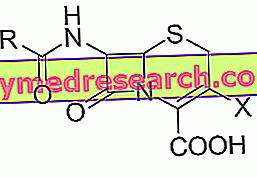Cephalosporins are β-lactam antibiotic drugs with bactericidal properties.
Introduction

General structure of cephalosporins
Cephalosporins have natural origins.
Cephalosporin C - the progenitor of this class of antibiotics - was isolated from the mycete Cephalosporium acremonium .
The discovery of cephalosporin C occurred in Italy, more precisely in Sardinia, thanks to the doctor Giuseppe Brotzu.
In fact, cephalosporin C was not powerful enough to be placed in therapy as such, so changes were made to its structure until it was possible to obtain its main nucleus: 7-aminocephalosporanic acid (or 7-ACA) .
Over the years, numerous modifications have been made to the 7-ACA core thus allowing the development of new cephalosporins more effective than their natural precursor and with a broader spectrum of action.
Indications
For what it uses
Cephalosporins are very effective in treating:
- Upper and lower respiratory tract infections;
- Skin and soft tissue infections;
- Bone and joint infections;
- septicemia;
- Endocarditis of infectious origin;
- Abdominal and gallbladder infections caused by Gram-positive bacteria sensitive to cephalosporins.
Action mechanism
Cephalosporins act by inhibiting the synthesis of the bacterial cell wall, in particular the peptidoglycan.
Peptidoglycan is a polymer made up of parallel chains of nitrogenous carbohydrates, joined together by transverse bonds.
Cephalosporins bind to transammidase, the enzyme involved in the formation of the above transverse bonds. The cephalosporin-transammidase interaction prevents the formation of these bonds, thus generating weak areas within the peptidoglycanic structure that lead to cell lysis and the consequent death of the bacterial cell.
Classification
Cephalosporins can be divided into four generations, depending on their spectrum of action.
First generation cephalosporins
First generation cephalosporins are active mainly towards:
- Gram-positive cocci;
- Β-hemolytic streptococci of group A;
- Streptococci of group B;
- Streptococcus pneumoniae .
They are not very effective against Gram-negatives, although some strains may be sensitive.
Cefapyrine, cefazolin, cephalexin, cefadroxyl and cefradine belong to this category.
Second-generation cephalosporins
Second-generation cephalosporins are effective against Gram-positive bacteria such as those of the first generation, but they are more effective against Gram-negatives.
This category includes cefamandolo, cefonicid, cefuroxime, cefoxitin, cafotetan, cafaclor, loracarbef and cefprozil .
Third generation cephalosporins
Third-generation cephalosporins have reduced efficacy against staphylococci (Gram-positive bacteria), but possess greater activity against Gram-negatives than first and second generation cephalosporins.
Cefotaxime, ceftizoxime, ceftriaxone, ceftazidime, cefoperazone, cefixime, ceftibuten, cefpodoxime, cefdinir and cefditoren belong to this category.
Fourth-generation cephalosporins
Fourth-generation cephalosporins possess an action spectrum very similar to that of third-generation cephalosporins, but they are also active against some types of enterobacteria resistant to the latter.
Cefepima is in this category.
Side effects
The most frequently occurring side effects during treatment with cephalosporins are mild and temporary nausea, vomiting and diarrhea. These effects are attributable to the interaction of the drug with the normal intestinal bacterial flora.
More rarely, severe diarrhea due to pseudomembranous colitis may occur. This effect is attributable to an infection with Clostridium difficile, an opportunistic anaerobic pathogen. This pathogen is normally found in the human microbiota and its growth is kept under control by other bacteria belonging to the same bacterial flora. However, following an antibiotic therapy - especially if long-lasting - the bacteria responsible for controlling the growth of C. difficile can be destroyed; this allows the pathogen to take over and allows him to establish an infection.
Rare cases of blood dyscrasias have also been reported following treatment with cephalosporins.
Finally, some cephalosporins can cause a prolongation of the bleeding time and favor the onset of acute alcohol intolerance.
Allergic reactions
Cephalosporins trigger allergic reactions less frequently than penicillins and can also be given to patients with a history of mild or delayed allergic reactions to penicillins.
However, in patients who have had acute and severe episodes of penicillin intolerance the use of cephalosporins is contraindicated.



